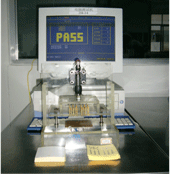Instructions and Precautions
Equipment Used
Contact Tester: Test points: 1-128 (can be extend to 256 ); Test time:
<0.5 seconds
Definitions
Transition Ring:
The transition ring is the visible ring on the top of the metal dome, where the dome radius
transitions into the feet of the dome. The transition ring is the hinge point of the dome that
forces the dome back to its original shape after the dome has been depressed or snapped over.
Bi-Stable:
The condition of a metal dome where, when actuated and then released, the metal dome does not
return to its original condition. In this state, the dome exhibits two (2) stable conditions.
Any damage to the transition ring will affect the metal domes ability to return to its original
form, thus reducing the domes actuation force, tactile ratio, or to the extreme, cause the dome
to become bi-stable.
Damage can occur to the metal dome by any of the following means:
-
Over-traveling the metal dome past its designed travel can cause damage to the transition
ring. For most domes this means traveling the dome past the flat plane of the feet.
Actuating the dome between the fingers with the center being unsupported is an example of
over-travel.
-
Denting the transition ring can be caused by actuating the metal dome with a sharp object
such as a pen or fingernail. (Rubbing the finger across the dome with the fingernail, for
example.)
-
Depressing the metal dome with a rigid, flat surface which is equal to or greater than the
transition ring diameter can cause damage to the transition ring. (Too large an actuator,
for example.)
-
Depressing the metal dome across the full width of the dome with some type of roller can
cause damage to the transition ring.
-
Actuating the metal dome when all of the feet are not evenly supported can cause damage to
the transition ring.
-
These are the most common causes of damage to the metal domes during assembly; yet do not
include all sources caused by general rough handling.

